Introduction to Treaty Law
This video lecture covers international non-proliferation and disarmament law in relation to treaty law, specifically:
- role of the Vienna Convention on the Law of Treaties
- creation of treaties
- joining of treaties
- general principle of international law Pacta sunt servanda
- termination of treaties
Focus on Treaties I: Joining Treaties
What is a Treaty?
an international agreement concluded between States in written form and governed by international law, whether embodied in a single instrument or in two or more related instruments and whatever its particular designation Vienna Convention on the Law of Treaties (VCLT), Article 2(1)(a)
TODO
To join a multilateral treaty (a treaty that is open to three or more states), a state has to express its ‘consent to be bound’ by that treaty. This usually happens through either ratification or accession procedures:
- If a state has signed or wishes to sign the treaty while it is open for signature, it will follow the ratification procedure (see section 1).
- If a state has not signed the treaty while it was open for signature, it can join by going through the accession procedure (see section 2).
1. Consent to be bound by ratification
The consent of a state to be bound by a treaty may be expressed by […] ratification […]. Article 11, VCLT.
?
- Step 1 – Signature: state signs the treaty, often during a ceremony
- Step 2 – Domestic approval: state seeks domestic approval for the ratification of the treaty
- Step 3 – Deposit of Instrument of Ratification: state deposits its ‘instrument of ratification’, usually a very short, signed document, with the depositary (who is responsible for administering the treaty), which establishes the state’s consent to be bound

Signing the Chemical Weapons Convention
2. Consent to be bound by accession
The consent of a State to be bound by a treaty may be expressed by […] accession […]. Article 11, VCLT
?
This procedure usually applies if a state has not signed a treaty, for example because the timeframe for signature has closed. In that case, ratification is no longer possible, but accession is.
Step 1 – Domestic approval: state seeks domestic approval for accession to the treaty
Step 2 – Deposit of Instrument of Accession: state deposits its ‘instrument of accession,’ usually a very short, signed document, with the depositary (who is responsible for administering the treaty), which establishes the state’s consent to be bound
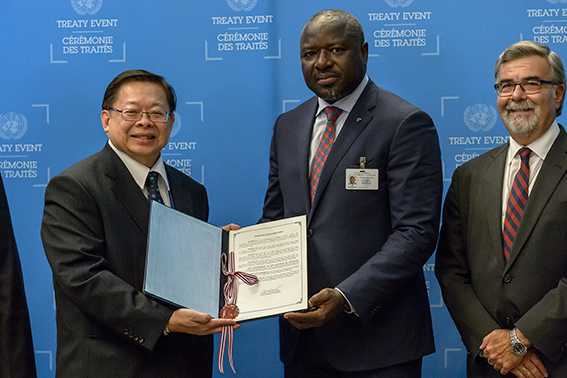
Thailand’s Instrument of Ratification for the CTBT.
Focus on Treaties II: Pacta sunt servanda
Entry into force
“Entry into force” of a treaty refers to the date on which the treaty becomes binding on the states that have expressed their consent to be bound it.
Multilateral treaties commonly require a certain number of states to have expressed their consent to be bound for the treaty to enter into force. The Comprehensive Test Ban Treaty, for example, even names the states whose consent to be bound is necessary for the treaty to enter into force (see CTBT, Article XIV, para 1).
Multilateral treaties usually also specify when the treaty shall enter into force for states that express their consent to be bound after a treaty has already entered into force (see for example CTBT, Article XIV, para 5).
Pacta sunt servanda (Latin for “agreements must be kept”): every treaty in force is binding upon its states parties. They must perform it in good faith (VCLT, Article 26).
Example: Comprehensive Test Ban Treaty
Article XIV:Entry into force
- This Treaty shall enter into force 180 days after the date of deposit of the instruments of ratification by all States listed in Annex 2 to this Treaty, but in no case earlier than two years after its opening for signature. […]
- For States whose instruments of ratification or accession are deposited subsequent to the entry into force of this Treaty, it shall enter into force on the 30th day following the date of deposit of their instruments of ratification or accession.
?
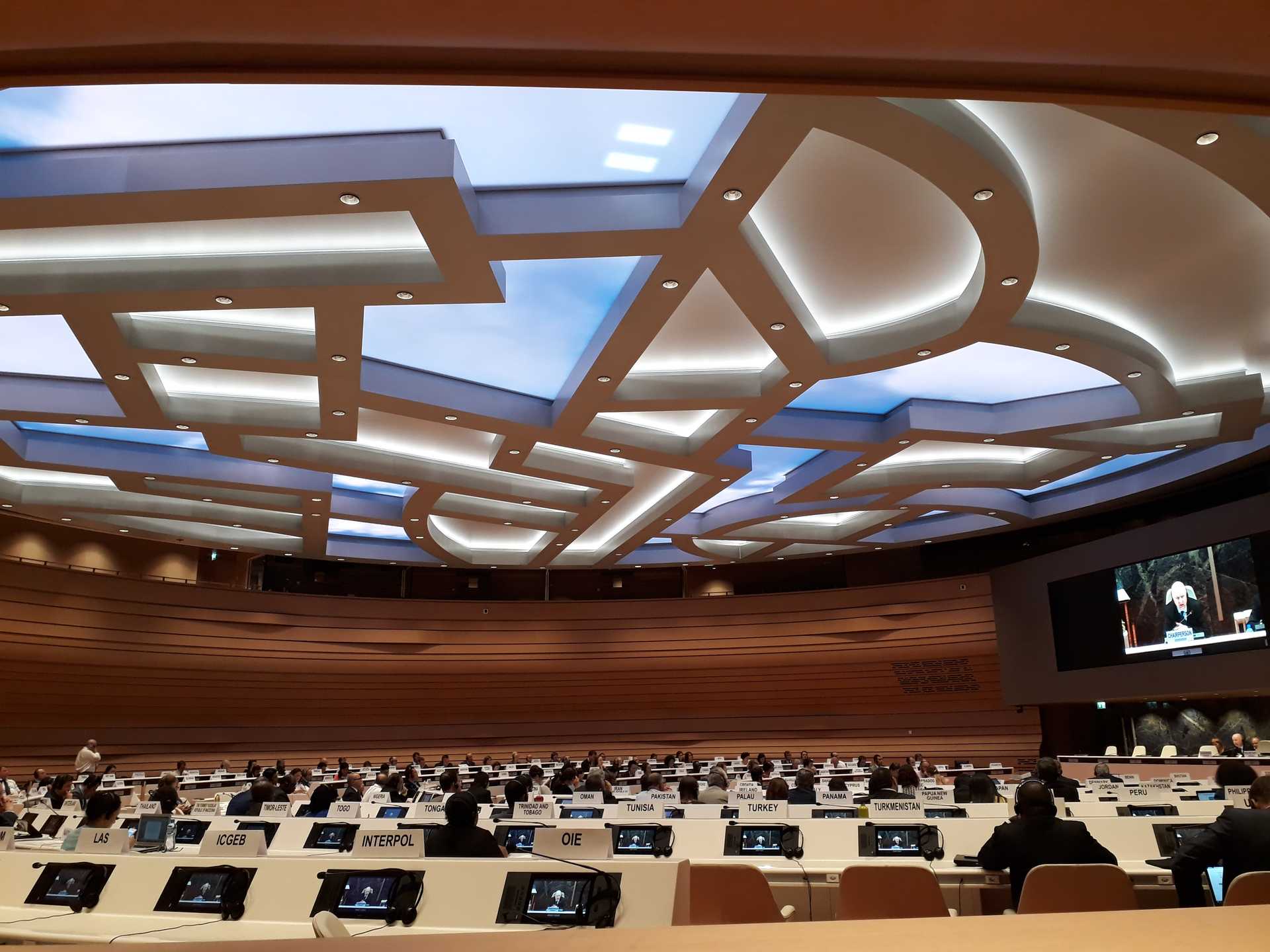
2018 BWC Meetings of Experts in Geneva, Switzerland
States who?
States that have signed, but not yet ratified a treaty are often referred to as Signatory States. As signatories, these states have the obligation to refrain from acts which would defeat the object and purpose of that treaty. VCLT, Article 18.
- states that have expressed their consent to be bound (by either ratification or accession) and for which the treaty is in force = States Parties
- states that have expressed their consent to be bound (by either ratification or accession), whether or not the treaty has entered into force = Contracting States
- Sometimes multilateral treaties establish international organisations. For example, the Chemical Weapons Convention establishes the Organisation for the Prohibition of Chemical Weapons. States Parties to the CWC are then also Member States of the OPCW (Article VIII (2)).
Focus on Treaties III: Interpreting and Amending Treaties
General Rule of Interpretation of Treaties (VCLT, Article 31)
Treaties shall be interpreted in good faith and in accordance with the ordinary meaning of their terms. However, the ordinary meaning will also depend on a treaty’s context and in light of its object and purpose.
Context refers to a treaty’s:
- preamble
- annexes
- agreements and instruments made in connection with the conclusion of the treaty Together with the context, the following shall be taken into account:
- subsequent agreements and practice regarding interpretation of the treaty
- any relevant rules of international law applicable to states parties’ relations
A special meaning to a term shall be given if it is established that the states parties so intended. This would require a high level of evidence.
Supplementary Means of Interpretation of Treaties (VCLT, Article 32)
Supplementary means of interpretation may be used as a recourse to confirm or determine the meaning of terms if the general rule of interpretation in Article 31:
A) Leaves the meaning ambiguous or obscure, or B) Leads to a manifestly absurd or unreasonable result.
Supplementary means of interpretation include the preparatory works of a treaty (known as travaux préparatoires) and the circumstances of the conclusion of a treaty.

CWC Conference of States Parties during which changes to the CWC’s Annex on Chemicals were adopted.
Amending Treaties
If states parties wish to alter treaty provisions, they can engage in a process to amend the treaty. In multilateral treaties, this process is usually outlined in one of the final articles of the treaty.
For example, States Parties to the Chemical Weapons Convention agreed to make changes to one of its annexes (amendments to annexes are referred to as ‘changes’ in the CWC). In November 2019, the Conference of States Parties agreed to add two families of toxic chemicals, known as novichok, to Schedule 1 of the Annex on Chemicals.
The procedure for these changes are outlined in Article XV of the CWC:
- Any State Party may propose amendments to this Convention. Any State Party may also propose changes, as specified in paragraph 4, to the Annexes of this Convention […].
- All changes to the Annex on Chemicals shall be made in accordance with paragraph 5.
?.
Paragraph 5 establishes clear procedures for each step, including:
- submission of the proposal for changes
- circulation of the proposal to all States Parties
- evaluation of the proposal
- approval procedures
- circulation of the adopted proposal
- entry into force of the proposed changes
Focus on Treaties IV: Multilateral Treaty Life-Cycle
Discover the life cycle of a multi-lateral treaty step by step. Use the ‘next’ button below to begin.
- Drafting and adoption of the treaty text
- States express their consent to be bound by the treaty (i.e. states join the treaty)
- Treaty enters into force (i.e. treaty becomes legally binding for those states that have already expressed their consent to be bound)
- Pacta sunt servanda: Treaty is observed, interpreted and possibly amended
- Not all treaties live forever. The treaty may be terminated or replaced by its States Parties by a new treaty
Example
- The CWC was negotiated and drafted in the Conference on Disarmament and adopted on 3 September 1992. France organised a signing ceremony in Paris on 13 January 1993, after which the treaty remained open for signature. 165 states signed the CWC.
- States started expressing their consent to be bound by the CWC. Fiji was the first state to express by depositing its instrument of ratification with the UN Secretary-General on 20 January 1993.
- Hungary was the 65th state to express its consent to be bound by ratification on 31 October 1996. Per Article XXI(1) of the CWC, the CWC entered into force on 29 April 1997, 180 days after this 65th deposit, for all 65 states that had already expressed their consent.
- Pacta sunt servanda: the CWC is applied and enforced in many different ways, from the destruction of chemical weapons stockpiles to the conduct of inspections by the OPCW and the adoption of implementation measures by its States Parties.
- The CWC is of unlimited duration (Article XVI(1)) and is silent on termination. It could therefore only be terminated if all States Parties consent to it (VCLT, Article 54). The CWC today has 193 States Parties.
Law on the Use of Force
This video lecture covers the following topic:
- international non-proliferation and disarmament law in relation to the international law on the use of force
Focus on Law on the Use of Force
The use of force by states in international law is governed by both customary and treaty law, with the UN Charter being the most relevant source:
Article 2(4) of the UN Charter prohibits the threat or use of force:
All Members shall refrain in their international relations from the threat or use of force against the territorial integrity or political independence of any state, or in any other manner inconsistent with the Purposes of the United Nations.
?
Exceptions to this prohibition exist:
Nothing in the present Charter shall impair the inherent right of individual or collective self-defence if an armed attack occurs against a Member of the United Nations, until the Security Council has taken measures necessary to maintain international peace and security […]. Article 51 of the UN Charter.
?
Chapter VII of the UN Charter provides for enforcement measures that can be taken by the UN Security Council, including the authorisation of the use of force.
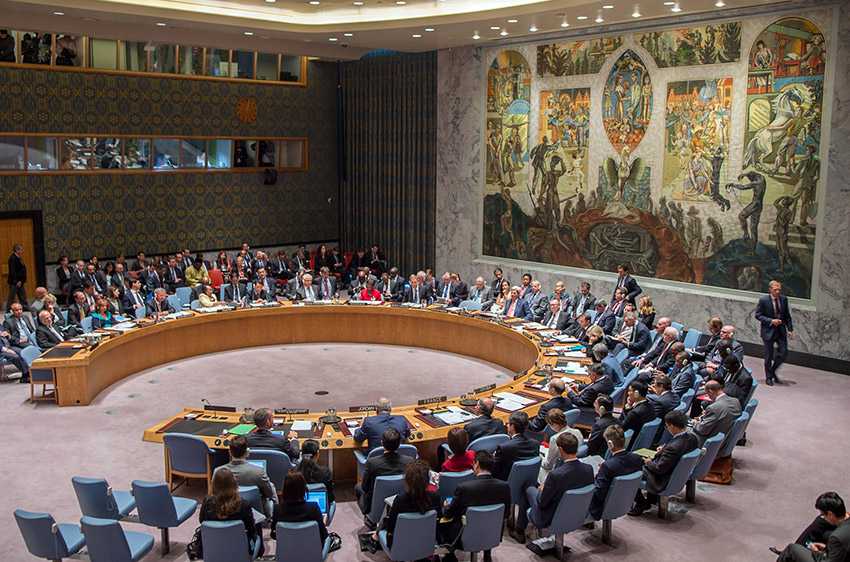
United Nations Security Council
International Humanitarian, Criminal and Human Rights Law
This video lecture covers international non-proliferation and disarmament law in relation to:
- international humanitarian law
- international criminal law
- international human rights law
Focus on International Humanitarian Law
Regardless of whether the use of force was lawful or not, any resulting armed conflict is governed by international humanitarian law (IHL), also known as the law of armed conflict (LOAC).
IHL only applies at the time of an armed conflict, so not during peacetime. It regulates the conduct of armed conflict in order to protect both civilians and combatants. While IHL does not prohibit the use of violence, regulating it provides some relief and protection to all parties involved.
The International Committee of the Red Cross (ICRC) acts as the ‘guardian’ of IHL. It promotes the development of IHL and its implementation in national law.

International Committee of the Red Cross, Headquarters in Geneva
The Geneva Conventions and their Additional Protocols are treaties that form a crucial part of international humanitarian law.
With regard to CBRN materials, Additional Protocol I, for example, generally prohibits attacks on nuclear power stations.
In addition, customary international lawprovides relevant rules, including the prohibition of the use of chemical and biological weapons in armed conflict.
IHL also consists of principles , such as the principle of distinction between civilians, who are protected from attack, and combatants, who are permitted to directly participate in hostilities and may therefore be attacked.
Focus on International Criminal Law
The International Criminal Court (ICC)
The ICC is a permanent international criminal court based in The Hague, the Netherlands. It is established by the 1998 Rome Statute, which currently has 123 States Parties.
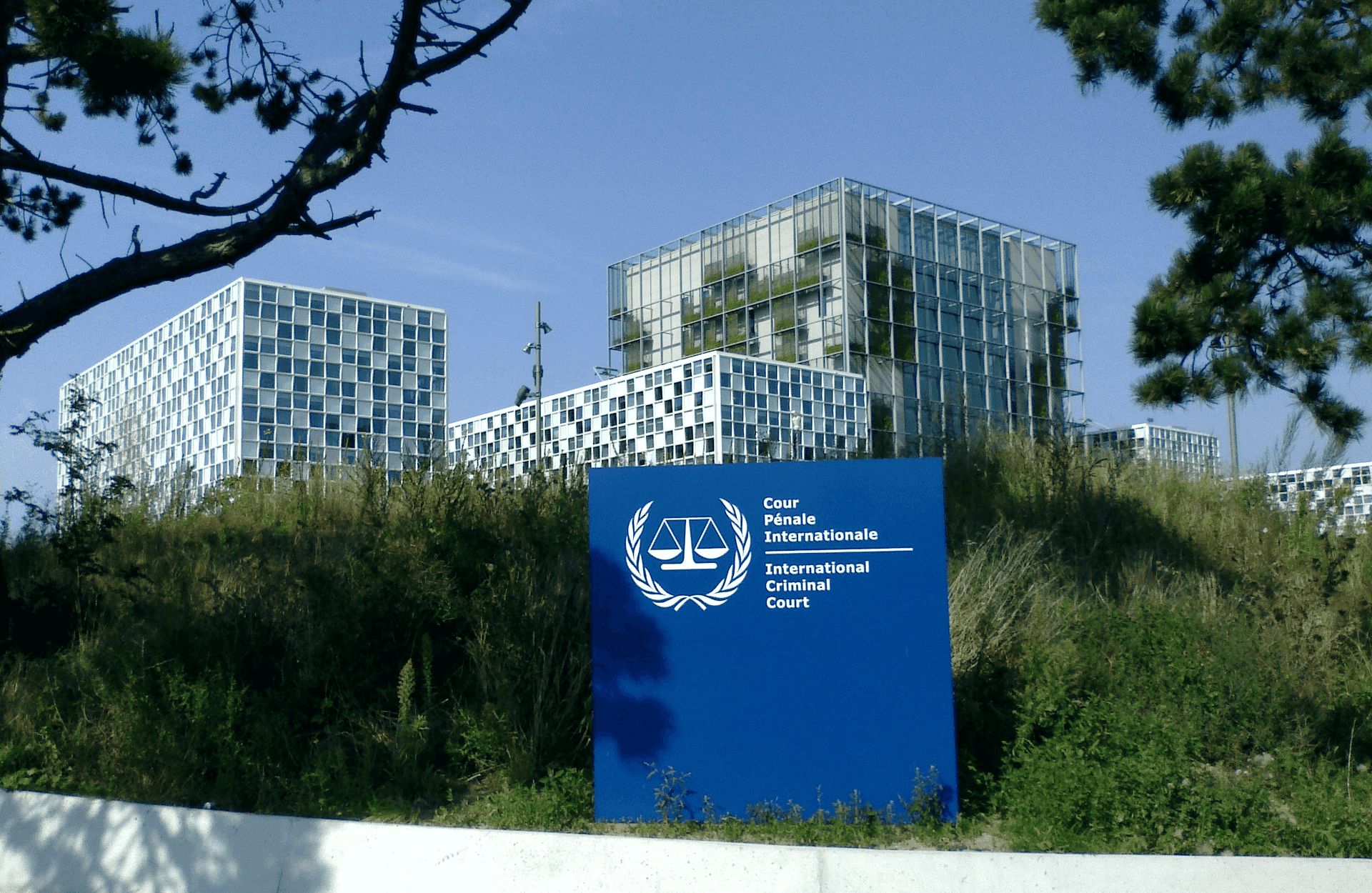
International Criminal Court in The Hague
The Court’s Jurisdiction
The Court has jurisdiction over ‘the most serious crimes of international concern’. These include:
- the crime of aggression: the planning, preparation, initiation or execution of the use of force which constitutes a manifest violation of the UN Charter (see also page 27)
- war crimes: grave breaches and other serious violations of IHL (see also page 29)
- crimes against humanity: certain acts committed as part of a widespread or systematic attack against a civilian population. Unlike war crimes, crimes against humanity can also be committed during peacetime
- the crime of genocide: certain acts committed with intent to destroy, in whole or in part, a national, ethnical, racial or religious group. Like crimes against humanity, genocide can be committed during peacetime and armed conflict, but unlike crimes against humanity, genocide is targeted towards a specific group
Amendments
Article 8 of the Rome Statute was amended in 2010 to include the use of poison or poisoned weapons and asphyxiating, poisonous or other gases as war crimes in non-international armed conflict (i.e. an armed conflict between a state and a non-state armed group or between non-state armed groups).
Article 8 was amended again in 2017 to include the use of biological and toxin weapons as war crimes both during international and non-international armed conflict.
Focus on International Human Rights Law
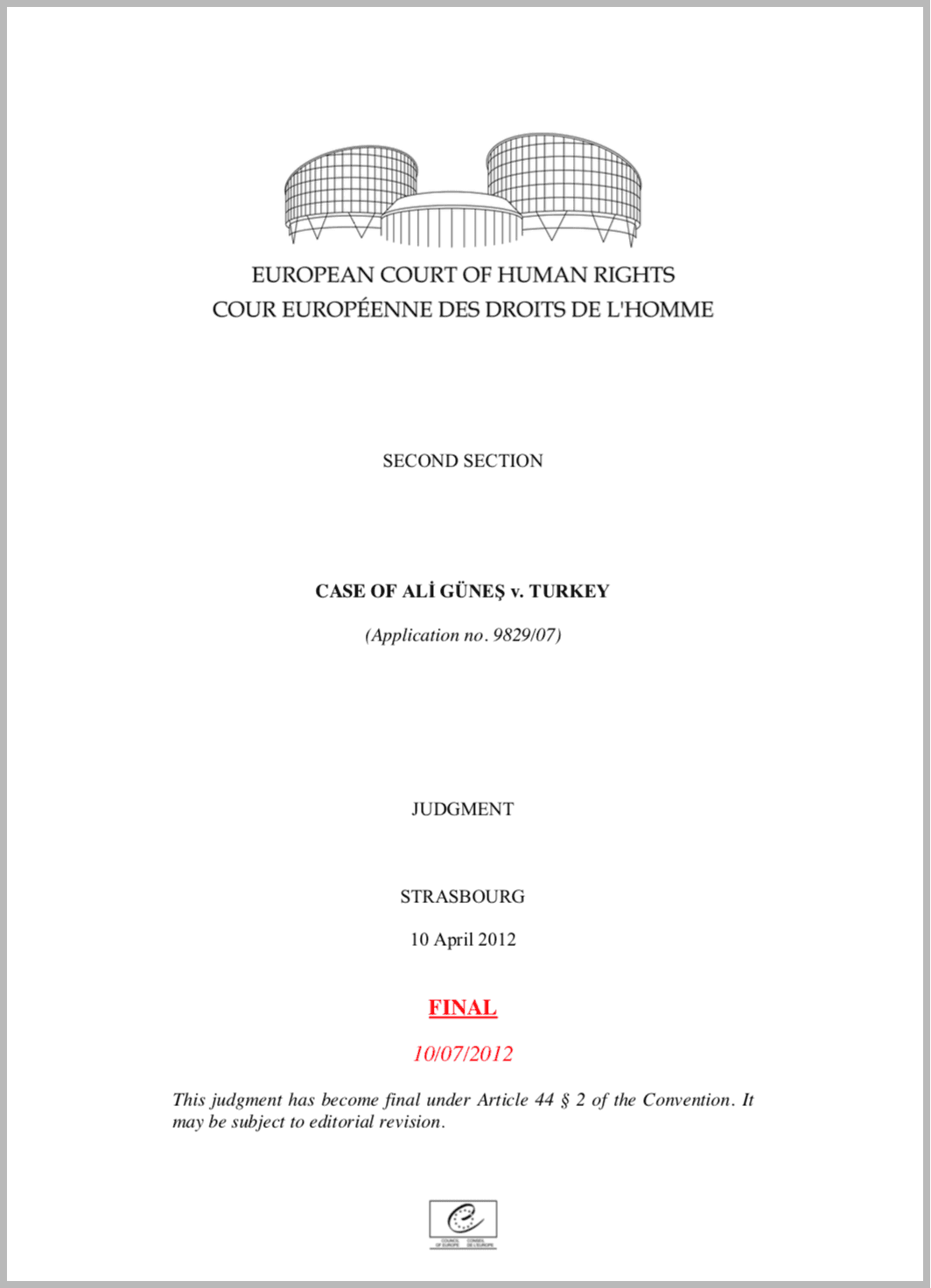
ECHR Judgment in 2012 in Ali Güneş v. Turke.
International human rights law IHRL grants protection to all individuals. It applies both during peacetime and armed conflict, although during the latter IHL takes precedence.
There are various international and regional treaties that protect and enforce human rights, including the European Convention on Human Rights which establishes the European Court of Human Rights ECHR in Strasbourg, France.
An example of the overlap between international human rights law and non-proliferation and disarmament law is the use of riot control agents.
While the Chemical Weapons Convention allows for the use of riot control agents for law enforcement purposes, such use is also governed by international human rights law. The ECHR noted this in, among other cases, Ali Güneş v. Turkey .
In this case, the Court held that the use of tear gas on a participant in a protest after his arrest was a violation of his right in Article 3 of the Convention to not be subjected to inhuman or degrading treatment.